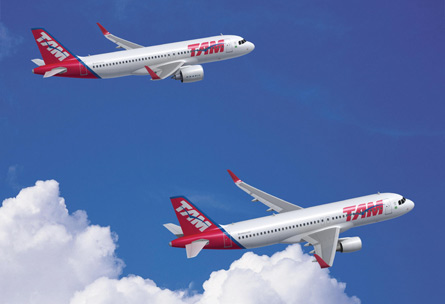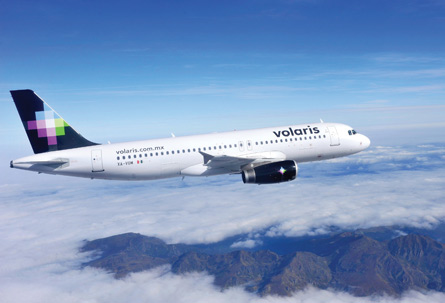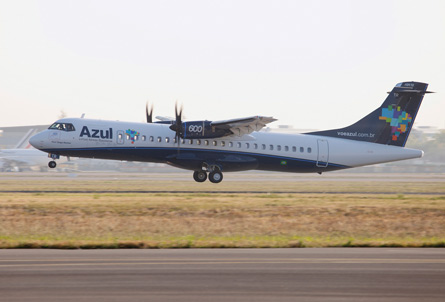In its latest market outlook for Latin America, Boeing says growth of the region's economies is expected to spur traffic growth. Traffic carried by Latin American carriers is expected to grow by 6.9% a year.
"Traffic within the region is expected to grow at a rapid pace, most quickly within South America, where growth will average 7% per year," Boeing's market outlook states. "By 2030, South America will have the sixth-largest internal traffic flow among the regions."
 |
|---|
© Airbus TAM will be latin America's first A320neo customer |
While Latin American airlines account for 48% of the traffic to, from and within the region, Boeing says this is expected to grow to 61% by 2030. This is partly driven by airlines consolidating in the region, says the airframer. Avianca and Taca completed a merger in 2010 and Chilean airline group LAN and Brazil's TAM expect to close on their merger in April.
Boeing forecasts the Latin American region will have a fleet of 3,390 aircraft by 2030. Embraer predicts a fleet of 3,240 aircraft in service in 2030, up from 1,325 in 2010, representing a growth of 145%.
The narrowbody fleet in Latin America is set to grow the strongest. "Most of the fleet delivered over the next 20 years will be new single-aisle airplanes for travel within the region," says Boeing. "About 360 twin-aisle and larger airplanes will be used for connections with the rest of the world as international commerce increases," it adds.
NARROWBODY AMBITIONS
Narrowbodies account for 46% of all aircraft in service and 65% of the order backlog in the Latin American and Caribbean fleet, states Embraer in its market outlook.
Airbus predicts the Latin American and Caribbean region will have 2,508 aircraft deliveries from now until 2030, with aircraft in the 125-seat to 210-seat category taking up 1,375 deliveries or more than half of all deliveries.
The Airbus A320neo featured prominently in several orders placed by Latin American carriers last year for narrowbody aircraft. AviancaTaca signed a memorandum of understanding for 51 A320s, including 33 A320neos, at the Paris air show in June 2011. The airline firmed up the order in January and will use the new aircraft to expand into new markets in Latin America.
As of end-January, the carrier has 88 A320 family aircraft in service, says Airbus.
LAN-TAM also signed orders for the A320neo in 2011, with LAN ordering 20 A320neos at the Paris air show. LAN holds 172 orders for Airbus aircraft as of end-February 2012, with most of them for the A320 family.
In October 2011, TAM firmed up a deal for 22 A320neos and 10 A320 standard aircraft, to be delivered from 2016 to 2018. The order made TAM the A320neo launch customer in Latin America. It was already a substantial A320 operator and was operating 126 A320 family aircraft as of end-February 2012.
 |
|---|
© Airbus Mexico's Volaris operates a fleet of 34 A320 family aircraft |
Latin American legacy carriers are not the only ones placing orders. Mexican low-cost carrier Volaris firmed up an order for 44 A320s in January, comprising 30 A320neos and 14 A320s. It first signed a provisional agreement for the aircraft in November 2011. As of end-February, Volaris was operating a fleet of 34 A320 family aircraft, according to the Airbus orderbook.
Fellow Mexican low-cost carrier Interjet has also expressed interest in the A320neo. It already has 33 A320s in operation, with eight more on order. Besides the A320neo, Interjet has also said it is keen to convert its five Sukhoi Superjet 100 options into firm orders. It has firm orders for 15 of the type. Interjet chief executive Jose Garza has said the airline plans to use the Superjet 100s to enter mid-density domestic markets where it cannot be profitable with the A320.
For Boeing narrowbodies, Aeromexico, Copa Airlines and Gol are major operators in Latin America. Copa placed an order for 20 Boeing 737-800s in end 2010 and is gradually taking delivery of the aircraft. It will take delivery of 13 new 737-800s in 2012 and return three for a net growth of 10 aircraft, and will receive seven more in 2013.
In late 2010, Gol also placed an order for 20 737-800s. The airline, which operates only 737 narrowbodies, has 103 aircraft in active service and 94 more on order, according to Flightglobal's ACAS database.
REGIONAL PROSPECTS
Besides narrowbodies, the prospects for regional aircraft in the region also look fairly healthy. Embraer, which has a substantial presence in Latin America, says it expects the region - along with China, the Middle East and Asia - to realise the potential of regional flying and to build their networks and right-size their fleets.
"For the most part, these markets were untouched by the regional jet revolution and have been the domains of large-capacity jets," Embraer states in its market outlook.
Embraer estimates the backlog of 570 regional aircraft in Latin America comprises 530 jets and 40 turboprops, and indicates this backlog could rise. It points out that in 2010, about 75% of all flights operated with jets with more than 120 seats but had passenger loads that were more appropriate for aircraft with 30 to 120 seats.
"Using right-sized equipment allows airlines to maximise operational efficiency and profitability," says the airframer. "As the region becomes more integrated through the development of an intra-regional network, there will be an opportunity for up to 120 seat jets to increase network connectivity and expand service to secondary airports," it adds.
 |
|---|
© Azul Brazilian carrier Azul has placed an order for 11 Embraer 195s in October 2011 |
It forecasts a need for 670 new regional jets in the next 20 years, of which 69% will be to support growth while the remaining 31% will be to replace old aircraft. "The 30 to 120-seat jet fleet will increase from 390 units in 2010 to 1,000 by 2030, with 30% of the current fleet still in service by then," says Embraer.
Latin American airlines have expressed interest in Embraer's re-engined E-jet, which could be available as soon as 2016. Copa Airlines and Brazil's Azul have both said they are keen. Azul announced an order for 11 Embraer E-195s in October 2011 and does not plan to place new aircraft orders until 2015, giving it the option of considering the re-engined E-jet, says Azul chief executive David Neeleman.
Copa chief executive Pedro Heilbron has said the airline will take a "hard look" at the performance of re-engined aircraft coming up in the market, "especially for the E-195".
Aside from regional jets, Embraer also expects the turboprop fleet in service in Latin America will increase to 305 aircraft from 220. It expects 165 new turboprops to be delivered from 2011 to 2030, and 78% of these will be to replace old aircraft while 22% will support market growth. "By 2030, 3% of the current fleet will still be in service," says Embraer.
Turboprop aircraft manufacturer ATR has 49 aircraft on order in the region, with Azul holding 25 of those orders, according to Flightglobal's ACAS database.
In July 2010, Azul ordered 30 ATR 72-600 new generation turboprop aircraft, with 10 options. The carrier also leased eight ATR 72-200s but has started returning them with the arrival of the -600s.
Source: Flight International























